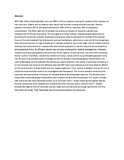Phytochemical Investigation of the Larvicidal Activity of Toddalia asiatica and Ekebergia capensis against Anopheles gambiae

View/
Date
2012Author
Korir, Erick Kipkoech
Type
ArticleLanguage
enMetadata
Show full item recordAbstract
With 500 million deaths globally, and over 90% in Africa, malaria is among the greatest killer diseases on the continent. Deaths due to malaria reach about half a million among children annually. Malaria patients constitute 15% of all hospital admissions, 50% of fever cases and 30% of outpatient consultations. The effect and cost of disease has enormous impact on economic growth and development of African economies. The emergence of drug resistant malaria parasite (plasmodium species) and insecticide resistant Anopheles mosquitoes have accelerated the spread of the disease. Some of the anti-malarials like chloroquine and pyrimethamine, which were used as first line drugs have been discontinued due to high prevalence of resistant parasites. Due to the high costs of malaria vaccine development and production coupled with diminished emphasis on vaccine research by multinational pharmaceutical firms, an efficient vaccine has not been produced for malaria management. However, research continues along these lines with two recent reports of new vaccines, one with 47% protection. Vector control. Therefore, remains the method of choice. Larval control is a preferable approach since the life cycle is terminated before emergence into the disease transmitting adults. Nonetheless, the used of biological control methods like larvivorous plants and fish is not viable. Insecticides resistance is on the increase and some of the effective ones like DDT have been banned due to their adverse effects on the environment, human health and non-target organisms. Thus, control strategies such as the use of phytochemical larvicides need to be investigated and developed. The current research examined the potential larvicidal activity of extracts of Toddalia asiatica and Ekebergia capensis. The extracts were subjected to bioassay guided fractionation and isolation of Larvicidal compounds. The results indicate that some extracts have larvicidal activity up to 19.0 ppm with T. Asiatic showing the highest activity. Several compounds were isolated and characterized from the two plants. Sibiricin from T. Asiatic showed the highest level of Larvicidal activity. Eight pure compounds are being reported for the first time from this study. Their bioactivity and structural elucidation are discussed.
URI
http://ir-library.ku.ac.ke/ir/handle/123456789/2436?show=fullhttp://erepository.uonbi.ac.ke:8080/xmlui/handle/123456789/36882
Publisher
College of Physical and Biological Sciences
